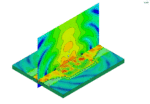As engineers continue to design more complex systems with increasing frequency, the need for speed and capacity to solve these structures also increases. Over the years, HFSS has come a very long way and can now solve exponentially large structures with millions of unknowns. Ansys HFSS never stopped advancing, continuing … Read More
Tag: ANSYS HFSS
Exponential Innovation: HFSS
The old adage: “If it ain’t broke, don’t fix it,” is as offensive to innovators as it is to grammarians. Just because something works well, doesn’t mean it cannot work better. As times change and technology advances, you either move forward or get left behind.
If you haven’t upgraded to the latest Ansys HFSS electromagnetic simulation… Read More
Whatever Happened to the Big 5G Airport Controversy? Plus A Look To The Future
In December 2021, just weeks before Verizon and AT&T were set to enable their new radio access networks in the 5G mid-band spectrum (also known as C-Band), the Federal Aviation Administration (FAA) released a Special Airworthiness Information Bulletin (SAIB) and a statement notifying operators of potential 5G interference… Read More
Podcast EP68: The Foundation of Computational Electromagnetics
Dan is joined by Dr. Matthew Commens, product manager Ansys. Matt discusses an upcoming webinar series on the inner workings and capabilities of Ansys simulation software. How the series began, the impact and benefits and a view of the future are all covered.
Webinar Series: Learn the Foundation of Computational Electromagnetics… Read More
5G and Aircraft Safety: Simulation is Key to Ensuring Passenger Safety – Part 4
In our previous blog installments, we examined the ingredient for modeling the potential for interference between a 5G C-band base station and an aviation radar altimeter. Using candidate emissions models for the transmitter, wideband susceptibility models for a candidate radar altimeter receiver and antenna and propagation… Read More
5G and Aircraft Safety: Simulation is Key to Ensuring Passenger Safety
The new 5G C-band service is now up and running in the U.S., and subscribers are finally starting to see some of the promise of 5G. The new C-band services are primarily in spectrum allocations between 3 and 4 GHz, providing the wider channel allocation bandwidths necessary to deliver significantly higher data throughput. At the… Read More
The Hitchhiker’s Guide to HFSS Meshing
Automatic adaptive meshing in Ansys HFSS is a critical component of its finite element method (FEM) simulation process. Guided by Maxwell’s Equations, it efficiently refines a mesh to deliver a reliable solution, guaranteed. Engineers around the world count on this technology when designing cutting-edge electronic products.… Read More
The 5G Rollout Safety Controversy
There has been a lot of attention in the news recently about AT&T and Verizon rolling out their first implementations of sub-6GHz 5G radio access networks (RAN). Notably, the FAA and airline industries have voiced serious concerns about potential safety issues for aircraft autopilot and landing systems. As a result of these… Read More
Can you Simulate me now? Ansys and Keysight Prototype in 5G
Ansys and Keysight wanted to see if they could answer the question, If we put virtual cellphones in different locations in a city, can we predict what kind of 5G signal we’re going to get in those locations? To find out, they created and tested a detailed virtual model of a city, including a variety of 5G antennae, receivers, and transmitters… Read More
There’s No Such Thing as Ground (But Perhaps There’s a Bob) Minimze Your Ports
I would contend there is no job quite like working as a support engineer for a simulation tool like Ansys HFSS. Such a role forces an engineer to understand technology in breadth and depth like no other because HFSS is applied to such a broad range of applications and products throughout the world. My own introduction to HFSS began … Read More










